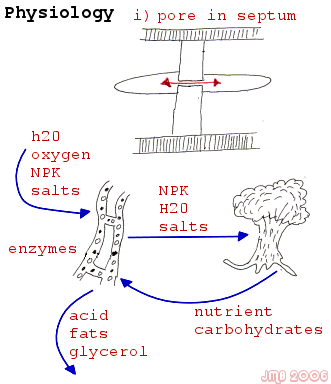|
Horn Of Plenty
Physiology
|

|
Physiology |
The food is distributed by simple circulation or streaming, protoplasm passing through a tiny pore in the centre of the septum of the hyphae [i]. It requires large amounts of water, free oxygen and carbohydrates. It uses nitrogen from the air. Elements essential for growth include K P Mg Su and traces of Fe Mang Cu Molyb Zn. Gallium also necessary. It assimilates carbohydrates from the host, including the former elements for growth, which it reserves as glycogen. Acids, fats and other compounds may be formed. To obtain the carbohydrates it produces large numbers of auxin, cyokinin and enzymes, which is a specialised organic substance composed of polymers of amino acids, that act as a catalyst to regulate the speed of the many chemical reactions involved in metabolism (chemical reactions). These hydrolytic enzymes accelerate reactions in which a substance is broken down into simpler compounds through reactions with water molecules. They are extraordinarily efficient. Minute quantities can accomplish at low temperatures, that would normally require violent reagents and high temperature. The fungi enables the root to receive nitrogen, nutrients and water more efficiently than the root itself. Tests have shown that they augment the absorption of salts and aid the tree on recovery of wilt, and aid trees resistance to pathogens. |

| |
Collated by James M. Burton as part of H.N.D. course at Pencoed
Agricultural College. Taxanomical information correct as of 06:06:97.